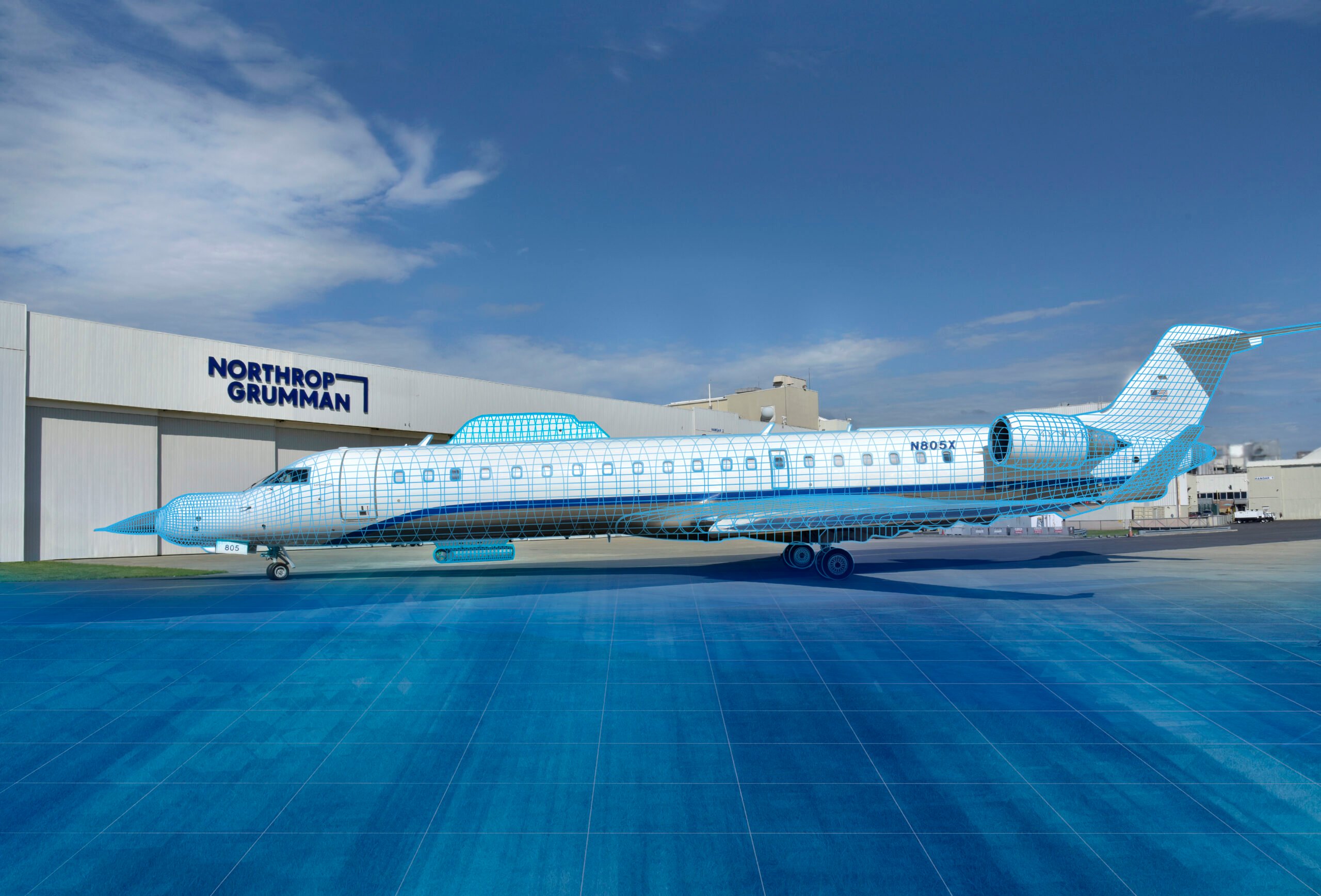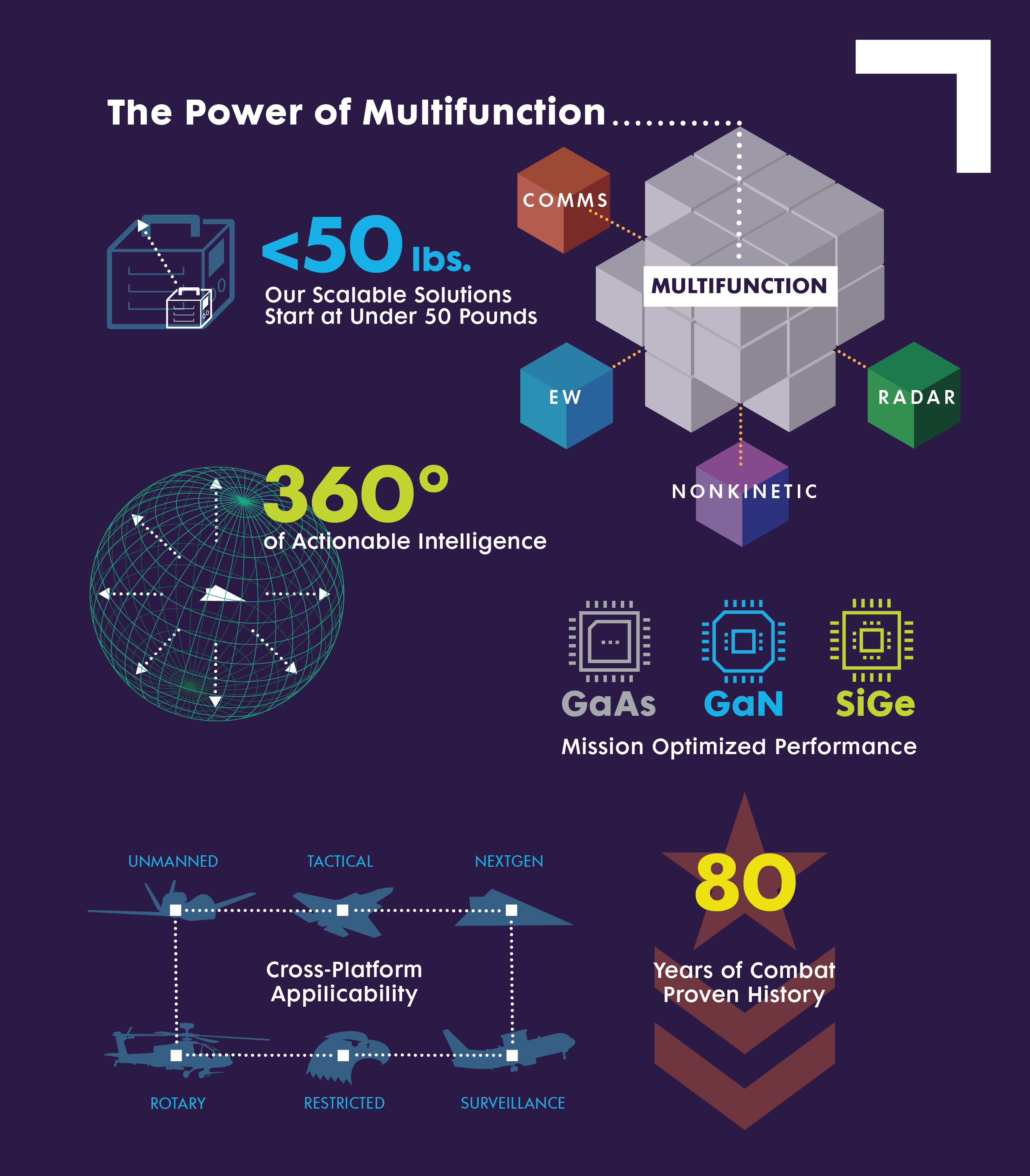
Northrop Grumman’s Digital Shadow, a virtual mission systems integration lab, provides the ability to correlate digital sensor representations with their physical design. Photo courtesy of Northrop Grumman.
With the Great Power competition, the threat against the US and its partners has moved to an extremely sophisticated stage where the US will meet near-peer challenges in numerous areas: long-range missiles, anti-access and area denial, remote targeting, command and control (C2), electronic warfare (EW), and cyber, to name several.
“Staying one step ahead on the battlefield calls for innovation in how our platforms and systems are developed, built, and acquired,” said Roshan Roeder, vice president and general manager of the Airborne Multifunction Sensors division at Northrop Grumman Mission Systems. “Instead of the long design-build-prototype-test cycle that we’ve used in the past, we are realizing digital capabilities to validate designs prior to hardware builds, and we are implementing product lines based on broadband multifunction building blocks to accelerate our overall deliveries to the warfighter.”
“To quickly and collectively observe, orient, decide and act (OODA) to address advanced threats, spectral agility and the use of multifunction sensors is the way of the future and a necessity. Using integrated capabilities across the overall electromagnetic spectrum decreases the adversary’s ability to deny operations and enhances the reliability and timeliness of situational awareness. This type of multifunction capability allows our systems to leverage adaptive methods and AI to respond to the changing warfighting environment in ways never seen before.”
Roles for multifunction sensors for EW, targeting, and C2
What is a multifunction sensor and how does it fit into the future battlespace and threat environment described above?
A multifunction sensor is an integrated system that consolidates multiple capabilities across the radio frequency (RF) spectrum – including communications, radar, electronic warfare, and intelligence, surveillance and reconnaissance (ISR) – into a single sensor.
This differs from multispectral sensors where two or more physically different systems, each sensing in its particular part of the spectrum, produce data that is fused together to create a more accurate picture of the target. Think of a multifunction sensor like a smartphone with multiple functions such as voice, text, camera, and navigation; the multifunction sensor includes many functions to satisfy different users and the data products must be highly reliable and secure.
“Depending on the requirement, we can provide higher-power multifunction sensors for larger platforms and different multifunction sensors with lesser size, weight, and power demands that are more appropriate for smaller, autonomous capabilities,” explained Roeder. “To be more agile and innovative, we’ve built our multifunction sensors on a set of building blocks that are all sensors, which reduces the number of apertures and power needed for individual sensors.”
“In addition, through the use of open-system architecture and software-defined networking we’re able to easily adapt sensors to specific multi-mission needs and create actionable data at the speed of relevance to the services.”
Multifunction sensors are especially suited to support future Joint All Domain Command and Control (JADC2) and multi-domain operations (MDO) to connect all five warfighting domains. That’s because multiple sensors operating across multiple frequencies give commanders a higher confidence set of actionable data that can improve both targeting and the OODA loop for precision fires. This is needed for the DoD to enact its Joint Warfighting Concept that is founded on the ability to gain and maintain decision dominance.
“The beauty of a multifunction sensor is that it is a single system to do radar sensing, electronic warfare, and communications — all of the capabilities that are needed for decision dominance,” said Roeder, adding that these sensors can have both passive and active capabilities in one system. Similar to the different apps on your cell phone, a multifunction sensor provides the information to support a variety of missions by giving responders a centralized set of information for better situational awareness.
Taking it one step further, there can be two, three or more multifunction sensors with those types of capabilities spread out across the threat environment. This would provide what Roeder calls “unprecedented situational awareness” for command and control in a multi-domain environment.

A multifunction sensor provides multiple capabilities and can seamlessly adapt to mission needs. Image courtesy of Northrop Grumman.
A new multifunction sensor to defeat complex, emerging threats
In mid-2021, Northrop Grumman Corporation delivered one of the most advanced multifunction sensors ever developed to the Air Force Research Laboratory (AFRL) and Defense Advanced Research Projects Agency (DARPA) for testing. Called the Arrays at Commercial Timescales-Integration and Validation (ACT-IV) system, it is based on an advanced multifunction digital active electronically scanned array (AESA).
The company calls the ACT-IV system a breakthrough in AESA performance and marks an important milestone in the nation’s transition to digitally reprogrammable, multifunction radio frequency (RF) systems. ACT-IV is one of the first multifunction systems based on a digital AESA using the semiconductor devices developed by the DARPA Arrays at Commercial Timescales program.
“The details of ACT are exciting, though the benefits are what is important,” said Roshan. “ACT technology enables agile multifunction systems, and our use of common ACT-based building blocks, supports rapid deployment of new capabilities to the warfighter.”
These new apertures are based on common building blocks with RF energy on one side and digital data over fiber on the other side. Digital building blocks allow the aperture to instantaneously transform from an AESA Radar, to a passive ESM receiver, to a datalink, to a “SIGINT” machine.
An array of multiple software defined apertures can provide all of these capabilities at a large scale or simultaneously at the building block or groups of building block levels. This has a massive effect on platform size, weight, and power (SWAP) reduction, simplified logistics, and overall cost of ownership for the warfighters, equippers, and acquirers. Northrop Grumman is using these building blocks to develop product lines across the full RF spectrum to support a wide range of platforms on land, sea and air.
Designing multifunction sensors with digital engineering in open architectures
One of the key concepts of multifunction sensors is that they are digitally engineered for an open architecture environment that facilitates the building block nature of multifunction sensor development. This makes it easier to share data between different sensors and enhance the sensor’s capabilities over time with new products and even another company’s product because of its open system.
“Open architecture is the premise upon which we’re building our developmental efforts,” said Roeder. “Our architecture lets us take some of our best-of-breed products and enhance them with third-party processing, functional modes/waveforms, and networking capabilities to eliminate any concerns around vendor lock. That enables us to create a sensor, maybe beyond the means of what the requirements are now, utilizing third-party capabilities to enable different functions on that multifunction sensor.”
Backing up these words, is a “Capability Development Kit,” or CDK, that is already in place along with training sessions for third parties.
Building-block construction and open architecture break vendor lock, and are cost-effective ways to build economies of scale and reduce the cost for product design, development, and production. In that vein, Northrop Grumman has also devoted resources to understanding what drives cost in the supply base and focused its digital transformation on helping third parties synthesize the engineering lifecycle aspects of multifunction sensors, according to Roeder.
Key to the company’s efforts in that respect is digital engineering. “Our deep understanding of the mission environment and threats allows us to take that experience and accurately model and analyze numerous, complex scenarios in the electromagnetic spectrum,” said Roeder. “Our customers are sharing more and more information about their needs so we’re able to run as many as 100,000 tests per night to validate changes in our system, predicated on real information and real data. It helps us enable the mission suite, optimize performance for the warfighter, and understand the technical performance that’s needed to meet our customers’ timelines and cost requirements.”
Me and my (digital) shadow
To assist in the work of rapid iteration and assessment of multiple configurations of mission systems such as multifunction sensors and radar systems for fighter aircraft, Northrop Grumman has developed what it calls its “Digital Shadow” testbed, also known as a digital twin. This is a digital replica of its flying experimental aircraft testbed airframe and subsystems.
“The digital twin will serve as a multi-spectral integration platform to allow us to simulate current and future capabilities on the aircraft, and select that virtual test performance so we can correlate predicted sensor performance to actual performance,” explained Roeder. “That further increases the fidelity and credibility of those digital representations. Using our Digital Shadow testbed is an iterative transformation for us.”
The digital testbed, which is a virtual mission systems integration lab, provides the ability to correlate digital sensor representations with their physical design, further validating system and performance models and leveraging Northrop Grumman’s large repository of collected data.
By creating a digital version of the aircraft and the onboard mission-system suites, the company can virtually configure, integrate, and fly scenarios and sensor combinations beyond the physical testbed limitations, increasing the breadth and scale of experimentation — reducing timeline and flight test costs, and ultimately extending mission capabilities for the warfighter to stay ahead of evolving threats.
“The digital environment lets us explore the huge test and performance space created by a multifunction system performing many functions on many threats across many frequencies and on many different platforms,” said Roeder. “A digital system can traverse many more tests in a shorter amount of time than would be humanly possible in a flight. So these digital twins are a necessary part of the multifunction, multi-domain infrastructure of our future fighting forces.”
Much like the cell phone has evolved to meet customer expectations, multi-domain operations are demanding an evolution in sensors in order to maintain spectrum superiority. Multifunction sensors can adapt to the mission need and scenario and dynamically support ISR, targeting, communications, electronic warfare and C2 requirements in a seamlessly integrated way. This will be necessary in defeating emerging threats in the complex and increasingly agile threat environment of MDO.





















